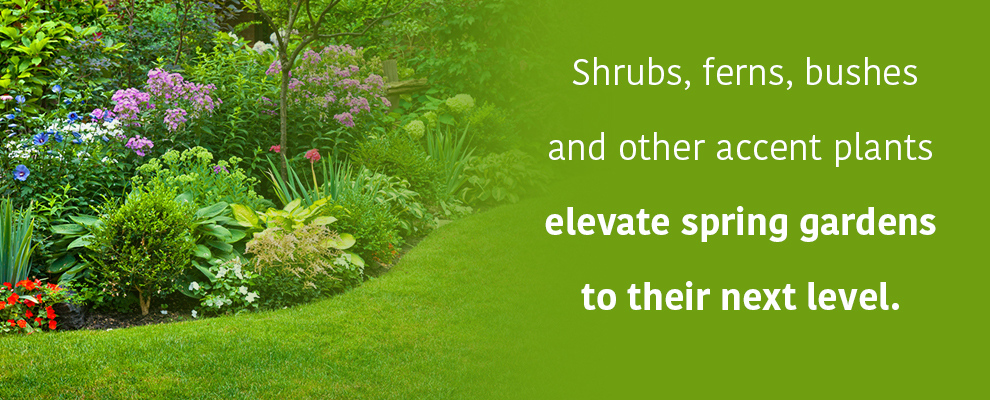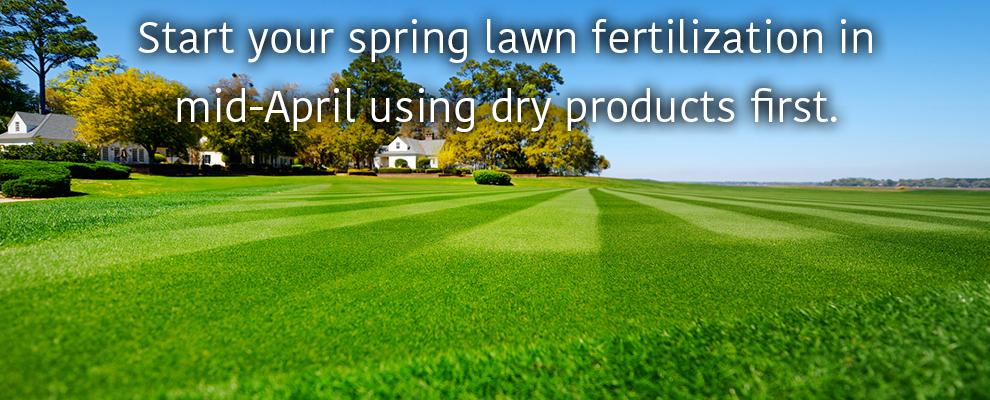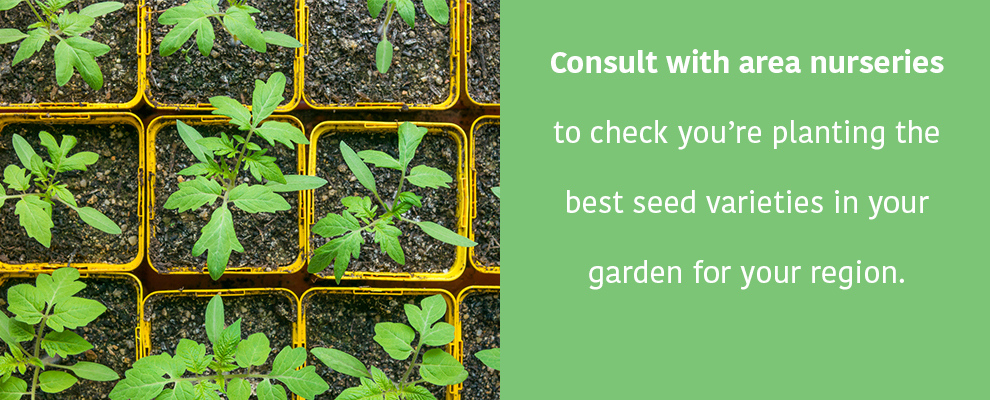
Fertilizing Tips for Spring Plantings and Gardens
There are few things as exciting after a long and cold winter as the promise of a new spring garden.
From planting a rainbow of tulips or growing enough tomatoes to feed the neighbors to nurturing a lawn soft and lush enough for bare feet, spring gardens signal the end of the harsh cold and the return of greenery. They brighten our yard, liven our home’s facade and create a warm, inviting space for all.
It’s hard to achieve all that without proper spring gardening practices, though — with one reigning supreme to counter the effects of winter: fertilizer.
Knowing which fertilizer to use on which spring plants, as well as proper feeding schedules and dosages, doesn’t take years of gardening or hours of labor. You can save time and money with these insider garden fertilizing tips and steps, nurturing your healthiest spring plantings to date.
Why Is Fertilizer Beneficial?
Fertilizer is to spring plants what salt is to a recipe. It’s a fundamental component, nurturing and encouraging your plant’s overall growth.
From its earliest root systems to budding leaf foliage to the development and ripening of fruit, fertilizer acts as a catalyst to jumpstart the natural evolution of a plant. It does so by providing extra doses of plant “food” — some much-need nutrients that rejuvenate a plant and its surrounding soil after winter’s wear and tear.
In addition to water and sunlight, every plant needs a solid base mix of three major nutrients: nitrogen, phosphorus, and potassium. These compounds help plants root and thrive. All fertilizers are made up of a formulaic combination of these three elements, either in equal proportion or with a larger ratio of one to foster a particular type of plant growth. You can read the percentages right on all fertilizer labels, with the first number indicating nitrogen content, the middle number phosphorus, and the final number potassium.

Organic vs. Synthetic Fertilizers
Understanding the differences between organic and synthetic fertilizers is essential for you to make the best purchase for your spring plantings.
Organic fertilizers are derived from natural sources: either plant or animal matter or some combination of the two. Such natural compounds include things like animal waste, manure, animal or fish meal, peat, emulsions and more. They will not only feed your desired spring plants but also nurture microorganisms deep within the soil itself.
Synthetic or inorganic fertilizers target a plant directly. They’re composed of mineral salts or mineral deposits that dissolve into the soil, often designed to be soluble for a specific growth or nutrient purpose.
Often, synthetic fertilizers get a bad reputation compared to their organic cousins. Misunderstandings behind synthetic compounds, as well their misuse or mishandling, contributes to these concerns. Yet there’s a growing wealth of research that puts manufactured fertilizer fears to rest and can help you make the best feed decision for your spring garden.
Types of Fertilizers
In addition to the organic versus synthetic classification, fertilizers come in a few principal varieties. Knowing how to fertilize your garden begins with picking the right type:
- Dry fertilizers: These come in pellets, granules or dry powders and are the most familiar to an avid home gardener. For best use, apply topically to a new garden bed already growing flowers, or lawns, trees and shrubs, in early spring.
- Liquid fertilizers: These are sprays or plant soaks that are fast-acting and convenient for a quick plant boost. They come in concentrated feeds you water down yourself or in already-mixed packages. Liquid fertilizers are best applied throughout spring on an as-needed nutritional and topical basis.
- Compost or manure: This is mostly organic fertilizer that not only nurtures the targeted plant but will also encourage widespread microorganism growth. They complement gardening tactics in both the fall and spring, preparing the soil before winter as well as enriching it for annual, biennial or perennial spring plantings.
- Slow-release fertilizers: These are less a variety and more a method. Compared to the fast-acting applications of liquid fertilizers, slow-release mixtures tend to come in dry granule form and will release nutrients across a span of three to six months. You can read on package labels if your fertilizer is slow-release or not as well as its feed period.

Selecting the Right Fertilizer
The best fertilizer for your spring plants is ultimately the one that fits your budget and your growth needs, encouraging the proper nutrient balance and root development without stripping too much from the soil.
Use the type of spring garden you’re planting as the basis for selecting the right fertilizer. Coordinating a garden type is the first key garden fertilizing tip that will align your compost purchase with what you intend to grow.
1. For Flowerbed Gardens
Recommendation: Espoma Flower-Tone; Soil Acidifier; Bloom Booster
Flowerbed gardens can be made up of annual, biennial or perennial plants that live only one year, two years or reoccur over the years, respectively. The most popular spring flowerbed plantings include tulips, daffodils, peonies, and hyacinths, though there are dozens of spring blooming flowers to choose from.
Garden flowerbeds typically require the least amount of fertilizer. In springtime, choose a slow-release, single-application fertilizer to apply topically before flowers bloom. Keep track of any yellow or light-green leaves on your flowers as they continue to grow. Use small, liquid fertilizer spot treatments in these areas if the discoloration continues.
2. For Produce Gardens
Recommendation: Espoma Tomato-Tone; Espoma Garden-Tone, Osmocote Flower & Vegetable Food
The joy of growing your own produce starts with healthy spring soil. Without a rich and nutrient-dense foundation at the cusp of the season, however, you’ll find your produce yields will be much smaller than expected down the road — plus less colorful and flavorful.
Consider starting your vegetable or fruit garden with an equal-ratio granular or liquid fertilizer. Then set a top layer of compost and mulch after adding seed or transplants.
This provides a healthy, deep-feeding nutritional base through the entirety of your garden soil and balances the water and sunlight your produce seeds will receive. Fertilize your spring produce gardens afterward — roughly every two weeks — up until mid-summer heat arrives.
3. For Lawns
Recommendations: Greenview Lawn Food; Organic Iron-Tone
Lawn fertilizers are convenient and readily available early on in the spring. Though they may not be considered part of your actual garden or gardening efforts, a blooming garden will look strange next to a miskept or unhealthy, patchy and yellowed lawn. As such, consider lawn fertilizing as important as the fertilization steps you’re undertaking with your garden and plant beds.
For new spring grass, opt for a granular, slow-release fertilizer with higher nitrogen ratios. Just don’t go too high! Any nitrogen reading exceeding 15 percent is typically excessive for most residential lawns, leading to overgrowth and then over-mowing.
4. For Garden Shrubs
Recommendations: Organic Holly-Tone, Marine Cuisine Time-Release
Shrubs, ferns, bushes and other accent plants elevate spring gardens to their next level. From flowering and ornamental shrubs to the thickest evergreen bushes, fertilizing your garden shrubs means topical treatments similar to what you apply to flowers.
Look for slow-release, general-formula granular fertilizers with a single application early in spring. Water the area immediately after you apply. Ensure you’ve spaced these garden plants correctly, giving the ornamental shrubs' and bushes’ larger root systems enough room to expand and thrive.

Fertilizing Amount and Schedule
Knowing when to fertilize your garden — plus exactly how much to apply — is the next all-important question to keep your spring blooms singing. Luckily, these fertilizing tips for gardens are simple and straightforward, following right in line with what kind of fertilizer you’ve just selected.
1. For Flower Gardens
Apply fertilizer in March or early April — whichever is more appropriate for when you can expect continued warm weather in your area. Since flower beds and flower gardens don’t need as much fertilizer, keep treatment amounts light — usually single applications with slow-release granules or powders that’ll soak from the surface into the soil.
If you aren’t seeing regular flowerbed growth by late April and early May, consider additional, fast-acting liquids that can give the buds an extra nutritional jolt in one setting.
2. For Produce Gardens
Granular or pellet fertilizers should be mixed two to four inches into the soil at the beginning of spring. Like flower gardens, this period sits in late March or early April, as the weather begins to consistently warm. Follow this same recommendation for compost or organic formulas. Liquid fertilizers, on the other hand, should remain three to four inches from any already-planted seeds, as they will naturally soak into the dirt.
Remember: with spring produce gardens you’re aiming for vibrant and nutritious soil. Keep early rounds of fertilization focused on soil health, with plant-directed treatments applied only as necessary if specific problems arise.
3. For Lawns
Even the healthiest lawns need a spring boost, especially after a particularly harsh or a dry winter season. Plus, if you want the full effect of a blooming garden, you can’t neglect the surrounding lawn.
Start your spring lawn fertilization in mid-April using dry products first. Continue fertilization every four to six weeks, using a manual spreader that drops pellets at a slow and low rate instead of flinging it wide. Apply fertilizer around the perimeter of your lawn and garden first, then move to cover the middle. Rotate and apply layers perpendicularly, and take care not to leave stray pellets behind on sidewalks or driveways.
4. For Garden Shrubs
Hardier woodsy shrubs and bushes respond best to high-nitrogen fertilizers. Purchase synthetic blends with four-one-one parts nitrogen or three-one-one parts nitrogen if pre-planting your shrubs. For post-planting, use classic surface applications or slight drill hole techniques, placing equal amounts of fertilizer granules in holes spaced a few inches apart.
The frequency of fertilizing garden shrubs will vary. New plants added to your landscaping at the beginning of the season may need two rounds of fertilizer to see a real impact while maintaining older shrubs will only require one annual round of fertilization in the middle of spring.

Proper Spring Garden Fertilizing: What to Do Once You’ve Picked the Right Fertilizer
You’ve got the perfect plants and plant “feed” picked out to create your lush garden and surrounding lawn. With these final steps, you can guarantee your garden goes the distance by fertilizing properly at every spring growth stage:
- Prepare your soil bed: For new garden beds and transplants, properly till and then mix pellet fertilizer into any base soil where you intend to place new plants or seeds. This step is known as "pre-planting" and comes with its own fertilizer-based nutritional needs. For most flowers or shallow-rooted plants, mix dry fertilizer three to six inches into the freshly tilled dirt. For vegetable or fruit-producing plants or woody shrubs, mix fertilizer roughly eight inches into the base soil. Consider adding compost if dirt feels particularly sandy or dry.
- Optimize for growth: After planting the desired seeds or garden transplants, shift your fertilizer focus onto nurturing what’s now growing. Purchase fertilizers with chemical formulas that match your plant type and its specific maturing needs. That might mean a nitrogen-heavy concentration for certain vegetable beds or potassium-rich formulas for garden flowers. Likewise, keep applications at half-rate in the first two weeks of growth. Opt for liquid and dry fertilizers with smaller spot applications.
- Maintain plant health as your garden matures: As flowers bloom and fruits and veggies ripen for harvest, shift your fertilizer again to more potassium or phosphorus-forward dry or liquid blends. As spring moves toward summer, it’s now about using fertilizer to bolster plant cells so gardens live longer and healthier. Add organic compounds into synthesized plant-maturing blends to keep spring plants long-lasting and preserve the soil's moisture levels.
There are even more garden-fertilizing tips and tricks to keep in mind for your healthiest spring plantings. From getting into the right gardening mindset to hacking your yard’s natural landscaping and resources, these steps will contribute to vibrant spring plantings from day one:
- Test your soil: Your soil is the blank canvas for your garden. As such, you want to ensure it's healthy all on its own before adding additional plant systems. Use a soil tester kit or hire a soil-testing service to diagnose the condition of your soil professionally. You can get in-depth readings on its chemical makeup and pH levels, guaranteeing you pick the perfect fertilizer for your soil’s exact needs.
- Select local adaptations: Consult with area nurseries to check you’re planting the best seed varieties in your garden for your region. What’s more, consult with these same plant folks to match preferred area fertilizers as well. Different regional soils carry different disease risks, moisture levels and nutrient compositions, all of which a local expert can help you navigate.
- Consider potting soil: In addition to the natural dirt that makes up your yard, consider additional potting soil for any decorative planters or small-scale flowers that could get crowded out amidst larger plants or shrubs. Look for organic planter mixes with fertilizers pre-blended for these special contained environments.
- Add mulch atop slow-release fertilizers: Adding mulch atop vegetable gardens and large, landscaped flowerbeds not only keeps the underlying soil cool and damp, but it actually enhances the effects of slow-release fertilizers you may have pre-planted early in spring. It also reduces the risk of damaging weeds growing in your garden.
- Follow packaging instructions: Fertilizers come with specific directions on their packaging on proper handling, application and storage. Following these instructions is in your garden’s best interests. Never go over the recommended feed amount. However, you can lighten up doses at your discretion to ensure you won’t burn or streak your plants — especially in early spring’s bed preparation and growth stages.
- Don’t overcomplicate things: Your garden should be a place of joy and ease. Take pride in what you’ve planted and don’t get lost in overthinking fertilizer types and applications. When in doubt with your spring garden, go ahead and rely on all-purpose, slow-releasing synthetic fertilizers and note how they work for next year. A little work and experimentation go a long way.
With Garden Goods Direct, spring fertilizing is made simple. Plants are as much a passion for us as they are a profession and our Quality Seal of Approval stands testament to that. We guarantee the best garden perennials, shrubs, and trees on the market — plus all the spring lawn and garden care products that go with it.
